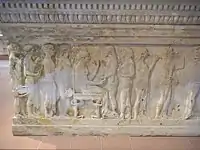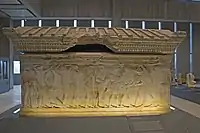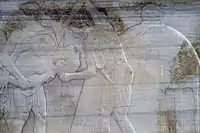Polyxena sarcophagus
The Polyxena sarcophagus is a late 6th century BCE sarcophagus from Hellespontine Phrygia, at the beginning of the period when it became a Province of the Achaemenid Empire.[1] The sarcophagus was found in the Kızöldün tumulus, in the Granicus river valley, near Biga in the Province of Çanakkale in 1994.[2] The area where the sarcophagus was found is located midway between Troy and Daskyleion, the capital of Hellespontine Phrygia.[1]
| Polyxena sarcophagus | |
|---|---|
 Relief of the sacrifice of Polyxena, Polyxena sarcophagus, Çanakkale Archaeological Museum. | |
| Material | Marble |
| Created | 520–500 BCE |
| Present location | Troy Museum, Turkey |
 Kızöldün tumulus | |

This is the earliest stone sarcophagus with figural reliefs ever found in Asia Minor.[2] The style is Late Archaic Greek and the sarcophagus dates to the last two decades of the 6th century BCE (520–500 BCE),[2][3] or slightly later (500–490 BCE), based on stylistic analysis.[4]
The reliefs represent a funerary celebration on three of its sides, and on the back what is believed to be the sacrifice of Polyxena, daughter of the king of Troy, Priam, by Neuptolemos in front of the tomb of his father Achilles.[2][5]
The description of the sacrifice of Polixena may be suggestive of a hero cult for Achilles, usually only involving animal sacrifice, on the spot of a Troad tumulus where he may have been buried.[5] Strabo (13.1.32) suggested that such a cult of Achilles existed in Troad:[6][7]
Near the Sigeium is a temple and monument of Achilles, and monuments also of Patroclus and Anthlochus. The Ilienses perform sacred ceremonies in honour of them all, and even of Ajax. But they do not worship Hercules, alleging as a reason that he ravaged their country.
The men shown in the reliefs are Greek, while the women are Trojans.[9]
 Side view.
Side view. Side view.
Side view. The sacrifice of Polyxena on the eponymous sarcophagus
The sacrifice of Polyxena on the eponymous sarcophagus The sacrifice of Polyxena on the eponymous sarcophagus (detail).
The sacrifice of Polyxena on the eponymous sarcophagus (detail). The sacrifice of Polyxena and tomb of Achilles.
The sacrifice of Polyxena and tomb of Achilles.
References
- Rose, Charles Brian (2014). The Archaeology of Greek and Roman Troy. Cambridge University Press. p. 72–. ISBN 9780521762076.
- Çanakkale Archaeological Museum notice
- Burgess, Jonathan S. (2009). The Death and Afterlife of Achilles. JHU Press. p. 115. ISBN 9781421403618.
- Rose, Charles Brian (2014). The Archaeology of Greek and Roman Troy. Cambridge University Press. p. 100. ISBN 9780521762076.
- Burgess, Jonathan S. (2009). The Death and Afterlife of Achilles. JHU Press. p. 114. ISBN 9781421403618.
- Burgess, Jonathan S. (2009). The Death and Afterlife of Achilles. JHU Press. p. 116. ISBN 9781421403618.
- Rose, Charles Brian (2014). The Archaeology of Greek and Roman Troy. Cambridge University Press. p. 79. ISBN 9780521762076.
- "Perseus Under Philologic: Str. 13.1.32".
- Rose, Charles Brian (2014). The Archaeology of Greek and Roman Troy. Cambridge University Press. p. 80. ISBN 9780521762076.
Further reading
- Draycott, Catherine M.; De Gruyter (2018). "Making meaning of myth. On the interpretation of mythological imagery in the Polyxena Sarcophagus and the Kızılbel Tomb and the history of Achaemenid Asia Minor". In Audley-Miller, L.; Dignas, B. (eds.). Wandering myths : transcultural uses of myth in the ancient world. Berlin/Boston. pp. 23–70. ISBN 9783110416855.
{{cite book}}: CS1 maint: location missing publisher (link)